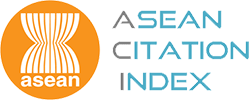คุณภาพด้านจุลชีววิทยาเพื่อการประเมินจุดควบคุมวิกฤติของการผลิตอาหารปริมาณมากในโรงอาหารมหาวิทยาลัย : กรณีศึกษายำไข่ต้ม, Microbiological Quality for Assessment of Critical Control Points of Mass production in the University Canteen : Case Study of Spicy Boil
Keywords:
คุณภาพด้านจุลชีววิทยา อันตรายทางชีวภาพ สารตกค้างของยาฆ่าแมลง การประเมินจุดควบคุมวิกฤติยำไข่ต้ม, microbiological quality, biological hazard, pesticide residue, assessment of critical control points, spicy boiled egg saladAbstract
การวิเคราะห์จุลชีววิทยาของการผลิตยำไข่ต้มปริมาณมากสำหรับการจำหน่ายในโรงอาหารมหาวิทยาลัย ผลจากการทดลองใช้เป็นข้อมูลพื้นฐานในการวิเคราะห์ ระบุอันตรายและใช้ในทำการประเมินจุดวิกฤติที่ต้องควบคุม ยำไข่ต้มประกอบด้วยส่วนผสมที่ผ่านความร้อนและไม่ผ่านความร้อน ส่วนผสมที่ผ่านความร้อนได้แก่ ไข่ หมูบด และกุ้งแห้ง ผลจากการวิเคราะห์พบว่าส่วนผสมเหล่านี้หลังผ่านการให้ความร้อนตรวจไม่พบจำนวนจุลินทรีย์ทั้งหมดและจุลินทรีย์ที่ก่อโรค (Salmonella, Staphylococcus aureus และ Vibrio parahaemolyticus) สำหรับส่วนผสมที่ไม่ผ่านความร้อนได้แก่ ขึ้นฉ่าย ต้นหอม ผักชี พริกขี้หนู ผักกาดหอม ทำการวิเคราะห์จุลินทรีย์ทั้งหมดก่อนและหลังล้างพบว่าไม่มีความแตกต่างทางสถิติที่ระดับนัยสำคัญ 0.05 ของจำนวนจุลินทรีย์ทั้งหมดในผักสดก่อนล้างและหลังล้าง นอกจากนี้จำนวนจุลินทรีย์ทั้งหมดหลังการล้างยังพบในปริมาณสูงและพบปริมาณสารตกค้างจากยาฆ่าแมลงในผักชีอยู่ในระดับไม่ปลอดภัย ยำไข่ต้มที่ปรุงเสร็จเมื่อตั้งที่อุณหภูมิห้องเพื่อรอการจำหน่ายที่เวลา 0, 2, 4, 6 และ 8 ชั่วโมง พบจำนวนจุลินทรีย์ทั้งหมดเพิ่มขึ้นตามระยะเวลาที่ตั้งรอการบริการจาก 6.0 × 104 cfu/g เป็น 4.5 × 104, 1.0 × 105, 2.4 × 105 และ 1.7 × 106 cfu/g ตามลำดับ ดังนั้นการพบจำนวนจุลินทรีย์ทั้งหมดในยำไข่ต้มที่อุณหภูมิห้องที่เวลา 0 ชั่วโมงเป็นผลจากส่วนผสมที่ไม่ผ่านความร้อน หลังจากตั้งยำไข่ต้มไว้ที่อุณหภูมิห้องเป็นเวลา 4 ชั่วโมงจำนวนจุลินทรีย์ทั้งหมดเพิ่มขึ้นอย่างมีนัยสำคัญ (p<0.05) และในชั่วโมงที่ 8 พบจำนวนจุลินทรีย์สูงกว่าเกณฑ์สำหรับอาหารพร้อมบริโภค การประเมินจุดควบคุมวิกฤติด้วยการใช้แผนภูมิการตัดสินใจ (decision tree) พบว่าจุดควบคุมวิกฤติของการผลิตยำไข่ต้มในปริมาณมาก คือ ขั้นตอนการล้างผักสด การให้ความร้อนในส่วนผสมที่ต้องทำให้สุก และระยะเวลาที่อาหารตั้งไว้ที่อุณหภูมิห้องก่อนบริโภค Analysis of microbiology was undertaken for the mass production of spicy boiled egg salad “Yam Kai Tom” in the university canteen and these results provided basic information for hazard analysis and the identification of critical control points. Spicy boiled egg salad is composed of cooked and uncooked ingredients mixed together. For the cooked ingredients; total aerobic plate count (TPC) and pathogen counts (Salmonella, Staphylococcus aureus and Vibrio parahaemolyticus) were not detected in eggs, minced pork, and dried shrimps after the heating process. For the uncooked ingredients; the TPC in vegetables (chinese celery, spring onion, coriander, hot chili and lettuce) remained at a high level after washing and the pesticide residue in coriander was at unsafe level. The TPC in the vegetables were not significant before and after the washing process. Spicy boiled egg salad held at ambient temperature for 0, 2, 4, 6 and 8 hours showed an increase in TPC from 6.0 × 104 to 4.5 × 104, 1.0 × 105, 2.4 × 105 and 1.7 × 106 cfu/g respectively. Thus, the TPC in spicy boiled egg salad held at ambient temperature for 0 hour there was a considerable resulting from the uncooked ingredients. The TPC was significant increase (p<0.05) after the product was held for 4 hours. The TPC at 8-hour-holding time was over the microbiological quality criteria of ready-to-eat food. The identification of the critical control points (CCPs) was conducted by using a decision tree. The critical control points (CCPs) for the spicy boiled egg salad production were indicated at the process of washing the raw vegetables, heating the cooked ingredients, and holding time at ambient temperature before serving.Downloads
Download data is not yet available.
Downloads
How to Cite
แจ่มผล อ., อุทัยพัฒนาชีพ อ., มหากาญจนกุล ว., & ลิ้มสุวรรณ ท. (2015). คุณภาพด้านจุลชีววิทยาเพื่อการประเมินจุดควบคุมวิกฤติของการผลิตอาหารปริมาณมากในโรงอาหารมหาวิทยาลัย : กรณีศึกษายำไข่ต้ม, Microbiological Quality for Assessment of Critical Control Points of Mass production in the University Canteen : Case Study of Spicy Boil. Science Essence Journal, 31(1), 141–157. Retrieved from https://ejournals.swu.ac.th/index.php/sej/article/view/5327
Issue
Section
Research Article








